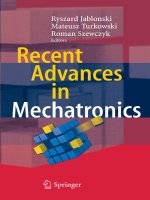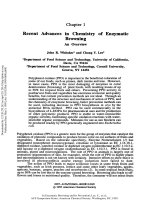Recent advances in computational optimization
Bạn đang xem bản rút gọn của tài liệu. Xem và tải ngay bản đầy đủ của tài liệu tại đây (11.99 MB, 306 trang )
Studies in Computational Intelligence 655
Stefka Fidanova Editor
Recent
Advances in
Computational
Optimization
Results of the Workshop on
Computational Optimization WCO 2015
Studies in Computational Intelligence
Volume 655
Series editor
Janusz Kacprzyk, Polish Academy of Sciences, Warsaw, Poland
e-mail:
About this Series
The series “Studies in Computational Intelligence” (SCI) publishes new developments and advances in the various areas of computational intelligence—quickly and
with a high quality. The intent is to cover the theory, applications, and design
methods of computational intelligence, as embedded in the fields of engineering,
computer science, physics and life sciences, as well as the methodologies behind
them. The series contains monographs, lecture notes and edited volumes in
computational intelligence spanning the areas of neural networks, connectionist
systems, genetic algorithms, evolutionary computation, artificial intelligence,
cellular automata, self-organizing systems, soft computing, fuzzy systems, and
hybrid intelligent systems. Of particular value to both the contributors and the
readership are the short publication timeframe and the worldwide distribution,
which enable both wide and rapid dissemination of research output.
More information about this series at />
Stefka Fidanova
Editor
Recent Advances
in Computational
Optimization
Results of the Workshop on Computational
Optimization WCO 2015
123
Editor
Stefka Fidanova
Department of Parallel Algorithms
Institute of Information and Communication
Technologies
Bulgarian Academy of Sciences
Sofia
Bulgaria
ISSN 1860-949X
ISSN 1860-9503 (electronic)
Studies in Computational Intelligence
ISBN 978-3-319-40131-7
ISBN 978-3-319-40132-4 (eBook)
DOI 10.1007/978-3-319-40132-4
Library of Congress Control Number: 2016941314
© Springer International Publishing Switzerland 2016
This work is subject to copyright. All rights are reserved by the Publisher, whether the whole or part
of the material is concerned, specifically the rights of translation, reprinting, reuse of illustrations,
recitation, broadcasting, reproduction on microfilms or in any other physical way, and transmission
or information storage and retrieval, electronic adaptation, computer software, or by similar or dissimilar
methodology now known or hereafter developed.
The use of general descriptive names, registered names, trademarks, service marks, etc. in this
publication does not imply, even in the absence of a specific statement, that such names are exempt from
the relevant protective laws and regulations and therefore free for general use.
The publisher, the authors and the editors are safe to assume that the advice and information in this
book are believed to be true and accurate at the date of publication. Neither the publisher nor the
authors or the editors give a warranty, express or implied, with respect to the material contained herein or
for any errors or omissions that may have been made.
Printed on acid-free paper
This Springer imprint is published by Springer Nature
The registered company is Springer International Publishing AG Switzerland
Preface
Many real-world problems arising in engineering, economics, medicine, and other
domains can be formulated as optimization tasks. Every day we solve optimization
problems. Optimization occurs in minimizing time and cost or maximizing profit,
quality, and efficiency. Such problems are frequently characterized by nonconvex,
nondifferentiable, discontinuous, noisy or dynamic objective functions, and constraints which ask for adequate computational methods.
This volume is a result of vivid and fruitful discussions held during the workshop on computational optimization. The participants have agreed that the relevance of the conference topic and the quality of the contributions have clearly
suggested that a more comprehensive collection of extended contributions devoted
to the area would be very welcome and would certainly contribute to a wider
exposure and proliferation of the field and ideas.
This volume includes important real problems such as parameter settings for
controlling processes in bioreactor, control of ethanol production, minimal convex
hill with application in routing algorithms, graph coloring, flow design in photonic
data transport system, predicting indoor temperature, crisis control center monitoring, fuel consumption of helicopters, portfolio selection, GPS surveying, and so
on. Some of them can be solved applying traditional numerical methods, but others
need huge amount of computational resources. Therefore it is more appropriate to
develop an algorithms based on some metaheuristic method like evolutionary
computation, ant colony optimization, constrain programming, etc., for them.
Sofia, Bulgaria
April 2016
Stefka Fidanova
Co-Chair, WCO 2015
v
Organization Committee
Workshop on Computational Optimization (WCO 2015) is organized in the
framework of Federated Conference on Computer Science and Information Systems
(FedCSIS)—2015
Conference Co-chairs
Stefka Fidanova, IICT, Bulgarian Academy of Sciences, Bulgaria
Antonio Mucherino, IRISA, Rennes, France
Daniela Zaharie, West University of Timisoara, Romania
Program Committee
David Bartl, University of Ostrava, Czech Republic
Tibérius Bonates, Universidade Federal do Ceará, Brazil
Mihaela Breaban, University of Iasi, Romania
Camelia Chira, Technical University of Cluj-Napoca, Romania
Douglas Gonçalves, Universidade Federal de Santa Catarina, Brazil
Stefano Gualandi, University of Pavia, Italy
Hiroshi Hosobe, National Institute of Informatics, Japan
Hideaki Iiduka, Kyushu Institute of Technology, Japan
Nathan Krislock, Northern Illinois University, USA
Carlile Lavor, IMECC-UNICAMP, Campinas, Brazil
Pencho Marinov, Bulgarian Academy of Science, Bulgaria
Stelian Mihalas, West University of Timisoara, Romania
Ionel Muscalagiu, Politehnica University Timisoara, Romania
Giacomo Nannicini, University of Technology and Design, Singapore
Jordan Ninin, ENSTA-Bretagne, France
Konstantinos Parsopoulos, University of Patras, Greece
vii
viii
Organization Committee
Camelia Pintea, Tehnical University Cluj-Napoca, Romania
Petrica Pop, Technical University of Cluj-Napoca, Romania
Olympia Roeva, Institute of Biophysics and Biomedical Engineering, Bulgaria
Patrick Siarry, Universite Paris XII Val de Marne, France
Dominik Slezak, University of Warsaw and Infobright Inc., Poland
Stefan Stefanov, Neofit Rilski University, Bulgaria
Tomas Stuetzle, Universite Libre de Bruxelles, Belgium
Ponnuthurai Suganthan, Nanyang Technological University, Singapore
Tami Tamir, The Interdisciplinary Center (IDC), Israel
Josef Tvrdik, University of Ostrava, Czech Republic
Zach Voller, Iowa State University, USA
Michael Vrahatis, University of Patras, Greece
Roberto Wolfler Calvo, University Paris 13, France
Antanas Zilinskas, Vilnius University, Lithuania
Contents
Fast Output-Sensitive Approach for Minimum Convex Hulls
Formation . . . . . . . . . . . . . . . . . . . . . . . . . . . . . . . . . . . . . . . . . . . . .
Artem Potebnia and Sergiy Pogorilyy
1
Local Search Algorithms for Portfolio Selection: Search Space
and Correlation Analysis. . . . . . . . . . . . . . . . . . . . . . . . . . . . . . . . . . .
Giacomo di Tollo and Andrea Roli
21
Optimization of Fuel Consumption in Firefighting Water
Capsule Flights of a Helicopter . . . . . . . . . . . . . . . . . . . . . . . . . . . . . .
Jacek M. Czerniak, Dawid Ewald, Grzegorz Śmigielski,
Wojciech T. Dobrosielski and Łukasz Apiecionek
Practical Application of OFN Arithmetics in a Crisis Control
Center Monitoring . . . . . . . . . . . . . . . . . . . . . . . . . . . . . . . . . . . . . . .
Jacek M. Czerniak, Wojciech T. Dobrosielski, Łukasz Apiecionek,
Dawid Ewald and Marcin Paprzycki
Forecasting Indoor Temperature Using Fuzzy Cognitive Maps
with Structure Optimization Genetic Algorithm . . . . . . . . . . . . . . . . . .
Katarzyna Poczęta, Alexander Yastrebov and Elpiniki I. Papageorgiou
Correlation Clustering by Contraction, a More Effective Method . . . . .
László Aszalós and Tamás Mihálydeák
Synthesis of Power Aware Adaptive Embedded Software
Using Developmental Genetic Programming. . . . . . . . . . . . . . . . . . . . .
Stanisław Deniziak and Leszek Ciopiński
39
51
65
81
97
Flow Design and Evaluation in Photonic Data Transport
Network . . . . . . . . . . . . . . . . . . . . . . . . . . . . . . . . . . . . . . . . . . . . . . . 123
Mateusz Dzida and Andrzej Ba̧ k
ix
x
Contents
Introducing the Environment in Ant Colony Optimization . . . . . . . . . . 147
Antonio Mucherino, Stefka Fidanova and Maria Ganzha
Fast Preconditioned Solver for Truncated Saddle Point
Problem in Nonsmooth Cahn–Hilliard Model. . . . . . . . . . . . . . . . . . . . 159
Pawan Kumar
The Constraints Aggregation Technique for Control of Ethanol
Production . . . . . . . . . . . . . . . . . . . . . . . . . . . . . . . . . . . . . . . . . . . . . 179
Paweł Dra̧ g and Krystyn Styczeń
InterCriteria Analysis by Pairs and Triples of Genetic Algorithms
Application for Models Identification . . . . . . . . . . . . . . . . . . . . . . . . . . 193
Olympia Roeva, Tania Pencheva, Maria Angelova and Peter Vassilev
Genetic Algorithms for Constrained Tree Problems . . . . . . . . . . . . . . . 219
Riham Moharam and Ehab Morsy
InterCriteria Analysis of Genetic Algorithms Performance . . . . . . . . . . 235
Olympia Roeva, Peter Vassilev, Stefka Fidanova and Marcin Paprzycki
Exploring Sparse Covariance Estimation Techniques in Evolution
Strategies . . . . . . . . . . . . . . . . . . . . . . . . . . . . . . . . . . . . . . . . . . . . . . 261
Silja Meyer-Nieberg and Erik Kropat
Parallel Metaheuristics for Robust Graph Coloring Problem . . . . . . . . 285
Z. Kokosiński, Ł. Ochał and G. Chrząszcz
Author Index . . . . . . . . . . . . . . . . . . . . . . . . . . . . . . . . . . . . . . . . . . . 303
Fast Output-Sensitive Approach
for Minimum Convex Hulls Formation
Artem Potebnia and Sergiy Pogorilyy
Abstract The paper presents an output-sensitive approach for the formation of
the minimum convex hulls. The high speed and close to the linear complexity of
this method are achieved by means of the input vertices distribution into the set of
homogenous units and their filtration. The proposed algorithm uses special auxiliary matrices to control the process of computation. Algorithm has a property of the
massive parallelism, since the calculations for the selected units are independent,
which contributes to their implementation by using the graphics processors. In order
to demonstrate its suitability for processing of the large-scale problems, the paper
contains a number of experimental studies for the input datasets prepared according
to the uniform, normal, log-normal and Laplace distributions.
1 Introduction
Finding the minimum convex hull (MCH) of the graph’s vertices is a fundamental
problem in many areas of modern research [9]. A set of nodes V in an affine space E
is convex if c ∈ V for any point c = σ a + (1 − σ )b, where a, b ∈ V and σ ∈ [0, 1]
[9]. Formation of the convex hull for any given subset S of E requires calculation of
the minimum convex set containing S (Fig. 1a). It is known that MCH is a common
tool in computer-aided design and computer graphics packages [23].
In computational geometry convex hull is just as essential as the “sorted sequence”
for a collection of numbers. For example, Bezier’s curves used in Adobe Photoshop,
GIMP and CorelDraw for modeling smooth lines fully lie in the convex hull of their
control nodes (Fig. 1b). This feature greatly simplifies finding the points of intersection between curves and allows their transformation (moving, scaling, rotating,
A. Potebnia (B) · S. Pogorilyy
Kyiv National Taras Shevchenko University, Kyiv, Ukraine
e-mail:
S. Pogorilyy
e-mail:
© Springer International Publishing Switzerland 2016
S. Fidanova (ed.), Recent Advances in Computational Optimization,
Studies in Computational Intelligence 655, DOI 10.1007/978-3-319-40132-4_1
1
2
A. Potebnia and S. Pogorilyy
Fig. 1 Examples of the minimum convex hulls
etc.) by appropriate control nodes [26]. The formation of some fonts and animation
effects in the Adobe Flash package also uses splines composed of quadratic Bezier’s
curves [10].
Convex hulls are commonly used in Geographical Information Systems and routing algorithms in determining the optimal ways for avoiding obstacles. The papers
[1] offer the methods for solving complex optimization problems using them as the
basic data structures. For example, the process of the set diameter calculation can be
accelerated by means of the preliminary MCH computation. This approach is finished
by application of the rotating calipers method to obtained hull, and its expediency is
based on the reduction of the problem dimensionality.
MCHs are also used for simplifying the problem of classification by implementing
the similar ideas. Let’s consider the case of the binary classification which requires
the finding of the hyperplane that separates two given sets of points and determines
the maximum possible margin between them. Acceleration of the corresponding
algorithms is associated with the analyzing of only those points that belong to the
convex hulls of the initial sets.
Last decades are associated with rapid data volume growth in research processed
by the information systems [22]. According to IBM, about 15 petabytes of new information are created daily in the world. Therefore, in modern science, there is a separate
area called Big Data related to the study of large data sets [25]. However, most of the
known algorithms for MCH construction have time complexity O(n log n), making
them useless when forming solutions for large-scale graphs. Therefore, there is a
need to develop efficient algorithms with the complexity close to linear O(n).
It is known that Wolfram Mathematica is one of the most powerful mathematical
tools for the high performance computing. Features of this package encapsulate a
number of algorithms and, depending on the input parameters of the problem, select
the most productive ones [21]. Therefore, Wolfram Mathematica 9.0 is used to track
the performance of the algorithm proposed in this article.
Fast Output-Sensitive Approach for Minimum Convex Hulls Formation
3
In recent years, CPU+GPU hybrid systems (GPGPU technology) allowing for
a significant acceleration of computations have become widespread. Unlike CPU,
consisting of several cores, the graphics processor is a multicore structure and the
number of its components is measured in hundreds [17]. In this case, the sequential
steps of algorithm are executed on the CPU, while its parallel parts are implemented
on the GPU [21]. For example, the latest generation of NVIDIA Fermi GPUs contains
512 computing cores, allowing for the introduction of new algorithms with largescale parallelism [11]. Thus, the usage of NVIDIA GPU ensures the conversion of
standard workstations to powerful supercomputers with cluster performance [19].
This paper is organized as follows. Section 2 contains the analysis of the problem complexity and provides the theoretical background to the development of new
method. A short review of the existing traditional methods and their improvements is
given in Sect. 3. Sections 4 and 5 are devoted to the description of the proposed algorithm. Section 6 presents the experimental data and their discussion for the uniform
distribution of initial nodes. In this case, the time complexity of the proposed method
is close to linear. However, effective processing of the input graphs in the case of the
low entropy distributions requires the investigation of the algorithm execution for
such datasets. Section 7 contains these experiments and their discussion.
2 Complexity of the Problem
Determination of similarities and differences between the computational problems is
a powerful tool for the efficient algorithms development. In particular, the reduction
method is now widely used for providing an estimation of problems complexity and
defining the basic principles for the formation of classification [4].
The polynomial-time reduction of the combinatorial optimization problem A to
another problem B is presented by two transformations f and h, which have the
polynomial time complexity. Herewith, the algorithm f determines the mapping of
any instance I for the original problem A to the sample f (I) for the problem B. At
the same time, the algorithm h implements the transformation of the global solution
S for the obtained instance f (I) to the solution h(S) for the original sample I. On the
basis of these considerations, any algorithm for solving the problem B can be applied
for calculation of the problem A solutions by including the special operations f and
h, as shown in Fig. 2.
The reduction described above is denoted by A ≤poly B. The establishment of such
transformation indicates that the problem B is at least as complex as the problem A
[21]. Therefore, the presence of the polynomial time algorithm for B leads to the
possibility of its development for the original problem A.
Determination of a lower bound on the complexity for the problem of convex hull
computing requires establishing of the reduction from sorting (SORT) to MCH. In
this case, the initial instances I of the original problem are represented by collections
X = x1 , x2 , . . . , xn , while the samples f (I) form the planar point set P. The function
f provides the formation of the set P by the introduction of the individual vertices
4
A. Potebnia and S. Pogorilyy
Fig. 2 Diagram illustrating the reduction of the computational problem A to the problem B
pi = (xi , xi 2 ) for items xi of the input collection. Therefore, the solutions S are
represented by the convex hulls of the points pi ∈ P, arranged on a parabola. The
mapping of solutions h requires only traversing of the obtained hull starting from the
leftmost point. This relation SORT ≤poly MCH describes the case in which the hull
contains all given points. But, in general, the number of nodes on MCH, denoted by
h, may be less than n.
It is known that the reduction relation is not symmetric. However, for the considered problems the reverse transformation MCH ≤poly SORT is also established, and
the Graham’s algorithm [14] demonstrates the example of its usage for the formation
of the convex hulls. This relation is satisfied for an arbitrary number of vertices in
the hull. Therefore, the complexity of the MCH construction problem is described
by the following system of reductions:
SORT ≤poly MCH, where h = n;
MCH ≤poly SORT , where h ≤ n.
According to the first relation, the lower bound on the complexity of the convex
hull computation for the case h = n is limited by its value for the sorting problem
and equals O(n log n). However, the second reduction shows that in the case h < n,
there is a potential to develop the output-sensitive algorithms that overcome this
limitation. The purpose of this paper is to design an approach for solving the MCH
construction problem, which can realize this potential.
In order to form the classification of the combinatorial optimization problems,
they are grouped into separate classes from the perspective of their complexity.
Class P is represented by a set of problems whose solutions can be obtained in
a polynomial time using a deterministic Turing machine. However, the problems
belonging to the class P have different suitability for the application of the parallel
algorithms. Fundamentally sequential problems which have no natural parallelism
are considered as P-complete. An example of such problem is the calculation of the
maximum flow. Per contra, the problems which have the ability to efficient parallel
Fast Output-Sensitive Approach for Minimum Convex Hulls Formation
5
Fig. 3 Internal structure of
the complexity class P
implementation are combined by the class NC ⊆ P. The problem of determining
the exact relationship between the sets NC and P is still open, but the assumption
NC ⊂ P is the most common, as shown in Fig. 3.
A formal condition for the problem inclusion to the class NC is determined as
the achievement of the time complexity O(logk n) using O(nc ) parallel processors,
where k and c are constants, and n is the dimensionality of the input parameters [12].
Both sorting and MCH construction problems belong to the class NC. Therefore, the
computation of the convex hulls has a high suitability for parallel execution, which
should be realized by the effective algorithms.
3 A Review of Algorithms for Finding the Minimum
Convex Hulls
Despite intensive research, which lasted for the past 40 years, the problem of developing efficient algorithms for MCH formation is still open. The main achievement
is the development of numerous methods based on the extreme points determination
of the original graph and the link establishment among them [8]. These techniques
include the Jarvis’s march [16], Graham’s Scan [14], QuickHull [5], Divide and
Conquer algorithm, and many others. The main features of their practical usage are
given in Table 1.
For parallelization the Divide and Conquer algorithm is the most suitable. It
provides a random division of the original vertex set into subsets, formation of partial
solutions and their connection to the general hull [23]. Although the hull connection
phase has linear complexity, it leads to a significant slowdown of the algorithm, and
as a result, to the unsuitability of its application in the hull processing for large-scale
graphs.
Chan’s algorithm, which is a combination of slower algorithms, has the lowest
time complexity O(n log h). However, it can work by the known number of vertices
contained in the hull [3]. Therefore, currently, its usage in practice is limited [6].
Study [2] gives a variety of acceleration tools for known MCH formation algorithms by cutting off the graph’s vertices falling inside an octagon or rectangle and
appropriate reducing the dimensionality of the original problem. The paper [15]
6
A. Potebnia and S. Pogorilyy
Table 1 Comparison of the common algorithms for MCH construction
Algorithm
Complexity
Parallel
Ability of generalization for the
versions
multidimensional cases
Jarvis’s march
Graham’s Scan
QuickHull
O(nh)
O(n log n)
O(n log n), in the worst
case −O(n2 )
Divide and Conquer O(n log n)
+
−
+
+
−
+
+
+
suggests numerous methods of convex hull approximate formation, which have linear complexity. Such algorithms are widely used for tasks where speed is a critical
parameter. But linearithmic time complexity of the fastest exact algorithms demonstrates the need for the introduction of new high-speed methods of convex hulls
formation for large-scale graphs.
4 Overview of the Proposed Algorithm
We shall consider non-oriented planar graph G = (V, E). The proposed algorithm
provides a division of the original graph’s vertex set into a set of output units U =
U1 , U2 , . . . , Un , Ui ⊆ V . However, unlike the Divide and Conquer method, this
division is not random, but it is based on the spatial distribution of vertices. All nodes
n
of the graph should be distributed by the formed subsets, i.e.
Ui = V . This allows
i=1
the presence of empty units, which don’t contain vertices. Additionally, the condition
of orthogonality division is met, i.e. one vertex cannot be a part of the different blocks:
Ui ∩ Uj = ∅, ∀i = j. In this study, all allocated units are homogeneous and have the
same geometrical sizes.
The next stage of the proposed algorithm involves the formation of an auxiliary
matrix based on the distribution of nodes by units. The purpose of this procedure is
the primary filtration of the graph’s vertices, which provides a significant decrease
in the original problem dimensionality. In addition, the following matrices define
the sets of blocks for the calculation in the subsequent stages of the algorithm and
the sequence of their connection to the overall result. An auxiliary matrix formation
involves the following operations:
1. Each block of the original graph Ui,j must be mapped to one cell ci,j of the
supporting matrix. Accordingly, the dimensionality of this matrix is n × m, where
n and m are the numbers of blocks allocated by the relevant directions.
2. The following operations provide the necessary coding of matrix’s cells. Thus, the
value of cell ci,j is zero if the corresponding block Ui,j of original graph contains
no vertices. Coding of blocks that contain extreme nodes (which have the lowest
Fast Output-Sensitive Approach for Minimum Convex Hulls Formation
7
and largest values of both plane coordinates) of a given set is important for the
algorithm. In particular, units, which contain the highest, rightmost, lowest and
leftmost points of the given data set are respectively coded with 2, 3, 4 and 5 in the
matrix representation. Other units that are filled, and contain no extreme peaks,
shall be coded with ones in auxiliary matrix.
3. Further, primary filtration of allocated blocks is carried out using the filled matrix.
Empty subsets thus shall be excluded from consideration. Blocks containing
extreme vertices shall determine the graph division into parts (called northwest,
southwest, southeast, and northeast) for which the filtration procedure is applied.
We shall consider the example of the block selection for the northwest section
limited with cells 2–3. If ci,j = 2, then the next non-zero cell is searched by successive increasing of j. In their absence, the next matrix’s row i + 1 is reviewed.
Selection of blocks is completed, if the value of the next chosen cell is ci,j = 3
(Fig. 4). Processing of the southwest, southeast, and northeast parts is based on a
similar principle. These operations can be interpreted as solving of the problem
at the macro level.
At the next step partial solutions are formed for selected blocks. Such operations
require the formation of fragments rather than full-scale hulls that provides the secondary filtration of the graph’s vertices. The last step of the algorithm involves the
connection of partial solutions to the overall result. Thus, the sequential merging of
local fragments is done on a principle similar to Jarvis’s march. It should be noted that
at this stage filtration mechanism leads to a significant reduction in the dimensionality
Fig. 4 Diagram demonstrating the traversing of the northwest matrix section limited with cells 2–3
8
A. Potebnia and S. Pogorilyy
of the original problem. Therefore, when processing the hulls for large graphs, the
combination operations constitute about 0.1 % of the algorithm total operation time.
We shall consider the example of this algorithm execution. Let the set of the
original graph’s vertices have undergone division into 30 blocks (Fig. 5a). Auxiliary
matrix calculated for this case is given in Fig. 5b. After application of the primary
filtration, only 57 % of the graph’s nodes were selected for investigation at the following stages of the algorithm (Fig. 5c). The next operations require the establishment of
Fig. 5 Example of the algorithm execution
Fast Output-Sensitive Approach for Minimum Convex Hulls Formation
9
the local hulls (Fig. 5d) and their aggregations are given in Fig. 5e. After performing
of the pairwise connections, this operation is applied repeatedly until a global convex
hull is obtained (Fig. 5f).
5 The Development of Hybrid CPU–GPU Algorithm
It is known that the video cards have much greater processing power compared to the
central processing elements. GPU computing cores work simultaneously, enabling to
use them to solve problems with the large volume of data. CUDA (Compute Unified
Device Architecture), the technology created by NVIDIA, is designed to increase
the productivity of conventional computers through the usage of video processors
computing power [24].
CUDA architecture is based on SIMD (Single Instruction Multiple Data) concept,
which provides the possibility to process the given set of data via one function.
Programming model provides for consolidation of threads into blocks, and blocks—
into a grid, which is performed simultaneously. Accordingly, the key to effective
usage of GPU hardware capabilities is algorithm parallelization into hundreds of
blocks performing independent calculations on the video card [27].
It is known that GPU consists of several clusters. Each of them has a texture
unit and two streaming multiprocessors, each containing 8 computing devices and
2 superfunctional units [13]. In addition, multiprocessors have their own distributed
memory resources (16 KB) that can be used as a programmable cache to reduce delays
in data accessing by computing units [24]. From these features of CUDA architecture,
it may be concluded that it is necessary to implement massively-parallel parts of
the algorithm on the video cards, while sequential instructions must be executed
on the CPU. Accordingly, the stage of partial solutions formation is suitable for
implementation on the GPU since the operations for each of the numerous blocks
are carried out independently.
It is known that function designed for executing on the GPU is called a kernel. The
kernel of the proposed algorithm contains a set of instructions to create a local hull of
any selected subset. In this case, distinguishing between the individual subproblems
is realized only by means of the current thread’s number. Thus, the hybrid algorithm
(Fig. 6) has the following execution stages:
1. Auxiliary matrix is calculated on the CPU. The program sends cells’ indexes that
have passed the primary filtration procedure and corresponding sets of vertices
to the video card.
2. Based on the received information, particular solutions are formed on the GPU,
recorded to its global memory and sent to the CPU.
3. Further, the procedure of their merging is carried out and the overall result is
obtained.
10
A. Potebnia and S. Pogorilyy
Fig. 6 Diagram illustrating a strategy of the parallel algorithm formation
It should be noted that an important drawback of hybrid algorithms is the need
to copy data from the CPU to the GPU and vice versa, which leads to significant
time delays [17, 20]. Communication costs are considerably reduced by means of
the filtration procedure.
When developing high-performance algorithms for the GPU it is important to
organize the correct usage of the memory resources. It is known that data storage
in the global video memory is associated with significant delays in several hundred
GPU cycles. Therefore, in the developed algorithm, the global memory is used only
as a means of communication between the processor and video card. The results of
intermediate calculations for each of the threads are recorded in the shared memory,
access speed of which is significantly higher and is equal to 2–4 cycles.
6 Experimental Studies of the Proposed Algorithm
for Uniformly Distributed Datasets
In this section, both coordinates of the input vertices have uniform distribution
U[a, b], where a and b are the minimum and maximum values of the distribution’s
support. The probability density of this distribution is constant in the specified interval [a, b]. Figure 11a shows the example of such dataset with the grid of units and
obtained global convex hull for a = 0 and b = 10.
For the respective datasets, the number of allocated homogeneous units, which
have the fixed average size, increases linearly with enhancing of the processed graphs
dimensionality. The complexity of calculating the relevant auxiliary matrices grows
by the same principle, and partial problems have the constant average dimensionality.
The stages of multi-step filtration and local hulls construction provide a significant
simplification of the final connection procedure. Therefore, its contribution to the
total running time is insignificant. Thus, the complexity of the developed algorithm
is close to linear O(n) for uniformly distributed data.
Fast Output-Sensitive Approach for Minimum Convex Hulls Formation
11
Fig. 7 Dependence of the developed algorithm performance on the graph dimensionality and the
number of vertices in the selected units for uniformly distributed datasets
MCH instances composed of all graph’s vertices are the worst for investigation.
In this case, the filtration operations don’t provide the required acceleration and
the lower bound on the complexity of the algorithm is determined by the reduction
SORT ≤poly MCH and equals O(n log n).
In the current survey, experimental tests were run on a computer system with an
Intel Core i7-3610QM processor (2.3 GHz), 8 GB RAM and DDR3-1600 NVIDIA
GeForce GT 630M video card (2GB VRAM). This graphics accelerator contains 96
CUDA kernels, and its clock frequency is 800 MHz.
Figure 7 shows the dependence of the proposed algorithm execution time on the
graph dimensionality and the number of vertices in the selected blocks. These results
confirm the linear complexity of the proposed method for uniformly distributed data.
In addition, it is important to set the optimal dimensionality of the subsets allocated
in the original graph. A selection of smaller blocks (up to 1000 nodes) leads to a
dramatic increase in the algorithm operation time.
This phenomenon is caused by the significant enhancing of the auxiliary matrices
dimensionality, making it difficult to control the computing process (Fig. 8). Per
contra, the allocation of large blocks (over 5000 vertices) is associated with the
elimination of the massive parallel properties, enhancing of the partial problems
dimensionality, and as a consequence, increasing of the algorithm execution time.
12
A. Potebnia and S. Pogorilyy
Fig. 8 Dependencies of the various stages performance on the graph dimensionality and the number
of vertices in the selected units
Thus, the highest velocity of the proposed method is observed for intermediate values
of the blocks dimensionality (1000–5000 vertices). In this case, auxiliary matrices
are relatively small, and the second stage of the algorithm preserves the properties
of massive parallelism.
One of the most important means to ensure the algorithm’s high performance
is the multi-step filtration of the graph’s vertices. Figure 9a shows the dependence
of the primary selection quality on the dimensionality of the original problem and
allocated subsets. These results show that such filtration is the most efficient with the
proviso that the graph’s vertices are distributed into small blocks. Furthermore, the
number of selected units increases with the raising of the problem’s size, providing
rapid solutions to graphs of extra large dimensionality. By virtue of a riddance from
the discarded blocks, the next operations of the developed algorithm are applied only
to 1–3 % of the initial graph’s vertices.
However, the results of the secondary filtration (Fig. 9b) are the opposite. In this
case, the highest quality of the selection is obtained on the assumption that the
original vertices are grouped into large subsets. Withal, the secondary filtration is
much slower than the primary procedure, so the most effective selection occurs at
intermediate values of the blocks dimensionality. As a result of these efforts, only
0.05–0.07 % of the initial graph’s vertices are involved in the final operations of the
proposed algorithm.
Fast Output-Sensitive Approach for Minimum Convex Hulls Formation
13
Fig. 9 The influence of the primary and secondary filtration procedures over the reduction in the
problem size
14
A. Potebnia and S. Pogorilyy
Fig. 10 A performance comparison between the new algorithm and built-in tools of the mathematical package Wolfram Mathematica 9.0 for uniformly distributed datasets
In order to determine the efficiency of the developed algorithm, its execution time
has been compared with the built-in tools of the mathematical package Wolfram
Mathematica 9.0. All choice paired comparison tests were conducted for randomly
generated graphs. The MCH formation in Mathematica package is realized by the
instrumentality of ConvexHull[] function, while the Timing[] expression is used to
measure the obtained performance. The results of the performed comparison are
given in Fig. 10. They imply that the new algorithm computes the hulls for uniformly
distributed datasets up to 10–20 times faster than Mathematica’s standard features.
7 Experimental Analysis of the Proposed Algorithm
for the Low Entropy Distributions
For a continuous random variable X with probability density function p(x) in the
interval I, its differential entropy is given by h(X) = − I p(x) log p(x)dx. High values of entropy correspond to less amount of information provided by the distribution
and its large uncertainty [18]. For example, physical systems are expected to evolve
into states with higher entropy as they approach equilibrium [7]. Uniform distributions U[a, b] (Fig. 11a), examined in the previous section, have the highest possible
differential entropy, which value equals log(b − a).
Therefore, this section focuses on the experimental studies of the proposed algorithm for more informative datasets presented by the following distributions:
1. Normal distribution N(μ, σ 2 ), which probability density function is defined as
√
1
2
p(x) = 1/σ 2π e− 2σ 2 (x−μ) , where μ is the mean of the distribution and σ is
its standard deviation. The relative differential entropy of this distribution is equal
to (1/2) log(2π eσ 2 ). Figure 11b shows the example of such dataset for μ = 5
and σ = 1.
Fast Output-Sensitive Approach for Minimum Convex Hulls Formation
15
Fig. 11 Examples of the distributions used for the algorithm investigation with the structures of
allocated units and received hulls
2. Log-normal distribution, whose logarithm is normally distributed. In contrast to
the previous distribution, it is single-tailed with a semi-infinite range and the
random variable takes on only positive values. Its differential entropy is equal to
log(2π σ 2 eμ+1/2 ). Example of this distribution for μ = 0 and σ = 0.6 is shown
in Fig. 11c.
3. Laplace (or double exponential) distribution, which has the probability density
|x−μ|
function p(x) = (1/2b) e− b that consists of two exponential functions, where
μ and b are the location and scale parameters. The entropy of this distribution is
equal to log(2be). Laplace distribution for μ = 5 and b = 0.5 is illustrated in
Fig. 11d.









